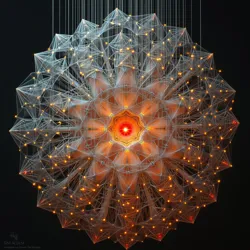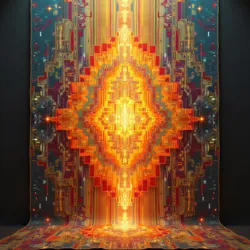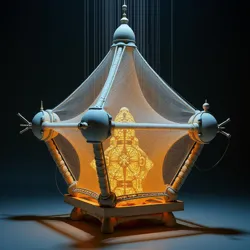The Thread Painters of Luminara
Welcome to the living textile archives of Luminara, where the art of thread manipulation shapes both architecture and society. Here you'll discover the intricate world of canvas breathing, dimensional weaving, and the ongoing artistic revolution that challenges centuries-old threading traditions. From the soaring silk-wrapped spires to the subterranean pattern workshops, Luminara's rich tapestry of innovation and tradition comes alive through the stories of its most influential thread painters.
Featured Article
Aria Threadweave's Revolutionary Pattern Techniques
 The experimental loom design used by Aria Threadweave to develop her breakthrough in three-dimensional threading patterns
The experimental loom design used by Aria Threadweave to develop her breakthrough in three-dimensional threading patternsAria Threadweave, formerly an apprentice pattern-maker in the Lesser Threading District, gained prominence through her groundbreaking work in canvas breathing techniques. Her discovery of the ancient Chromatic Resonance Scrolls in the dusty archives of the Suspended Library led to a renaissance in thread manipulation arts. The scrolls, dating back to the pre-Guild Era, contained detailed diagrams showing how specific geometric arrangements of treated threads could capture and release ambient light.
Working alongside the renowned Madame Vittoria Needlecraft, Threadweave developed new applications for these forgotten techniques. Their collaboration in the Tower of Ascending Patterns produced the first successful demonstration of three-dimensional thread effects in over two centuries. This achievement built upon principles established during the Great Color Symphony of 1423, when master craftspeople first succeeded in binding pigments to living fibers.
The partnership between Threadweave and Needlecraft challenged the conservative Guild of Static Patterns, whose influence over Luminara's textile arts had remained unchallenged for generations. Their experimental work in the High Loom Studios directly contradicted the Guild's Principles of Pattern Stability, particularly the controversial "Third Theorem of Unchanging Threads."
Did You Know...
-
The Chromatic Cotton Gardens produce naturally color-shifting fibers that change hue based on the angle of sunlight, making them highly sought after for advanced pattern work
-
During the Great Pattern Rebellion of 1892, underground weaving circles developed a secret language encoded entirely in knot patterns
-
The legendary Tapestry of Dawn's First Light was believed lost during the Great Thread Purge, until fragments were discovered in the Archived Pattern Vaults
Current Events
Guild Controversy Over New Threading Techniques
The recent unveiling of Threadweave and Needlecraft's experimental tapestry at the Annual Pattern Exhibition has sparked heated debate within Luminara's artistic community. Their work, which combines traditional Lunarweave patterns with newly rediscovered canvas breathing techniques, produced unexpected optical effects that many claim violate the fundamental laws of thread behavior.
 The controversial "Sunrise Resonance" tapestry created by Threadweave and Needlecraft, showing unprecedented light-capturing properties
The controversial "Sunrise Resonance" tapestry created by Threadweave and Needlecraft, showing unprecedented light-capturing propertiesThe Guild of Static Patterns has called for an emergency session of the Pattern Council to address what they term "dangerous deviations from established threading principles." However, support for the innovative techniques continues to grow among younger pattern-makers, particularly those studying at the Institute of Dynamic Weaving.
Underground Pattern Movement Gains Momentum
Reports indicate a growing network of experimental threading workshops operating in Luminara's Lower Pattern District. These unofficial studios, often hidden behind seemingly ordinary textile shops, have become centers for artists exploring non-traditional weaving techniques. The movement gained significant attention after several pieces displaying prohibited three-dimensional effects appeared in the Street Pattern Gallery.
Featured Technology
Canvas Breathing Apparatus
The rediscovery of canvas breathing has led to significant advances in thread manipulation technology. The Threadwave Amplification Chamber, developed by researchers at the Advanced Pattern Studies Laboratory, allows for precise control over the light-capturing properties of treated threads. This breakthrough has enabled the creation of self-illuminating tapestries and has applications in architectural threading.
 An experimental canvas breathing apparatus designed for precision thread treatment
An experimental canvas breathing apparatus designed for precision thread treatmentTrading and Commerce
The Grand Thread Exchange continues to be the center of Luminara's textile economy. Recent developments in canvas breathing techniques have created new markets for specially treated threads and exotic fiber blends. The Merchant's Guild reports increased demand for rare threading patterns and color-changing cotton varieties.
Particularly sought after are threads processed using the Vittoria Method, which combines traditional spinning techniques with principles derived from the Great Color Symphony. These specialized threads command premium prices in the Pattern Markets, especially those certified for use in three-dimensional weaving projects.
Architecture and Urban Development
Luminara's unique architectural style, characterized by buildings constructed from interwoven textile foundations, continues to evolve with the introduction of new threading techniques. The recently completed Tower of Living Patterns showcases the integration of canvas breathing principles into structural design, featuring walls that subtly shift in color throughout the day.
The Urban Pattern Council has approved plans for the renovation of the Historic Threading District, incorporating elements of both traditional and experimental weaving techniques. This project has faced opposition from Guild of Static Patterns conservatives, who argue that the use of dynamic threading patterns in architecture poses structural risks.
Education and Training
The debate over threading innovation has spread to Luminara's educational institutions. The prestigious Academy of Pattern Arts recently revised its curriculum to include studies in canvas breathing techniques, despite protests from traditionalist faculty members. Meanwhile, the experimental Workshop of Fluid Patterns continues to attract students interested in pushing the boundaries of traditional threading practices.
Research and Development
Recent breakthroughs in thread manipulation have led to the establishment of several research initiatives. The Pattern Innovation Institute focuses on developing new applications for canvas breathing technology, while the Fiber Integration Laboratory studies the properties of color-changing cotton varieties.
The discovery of the Chromatic Resonance Scrolls has sparked renewed interest in historical threading techniques. Scholars at the Suspended Library are working to decode additional ancient pattern documents, believing they may contain information about other lost threading arts.
Social Impact
The emergence of new threading techniques has had far-reaching effects on Luminaran society. Traditional social hierarchies, long based on mastery of established pattern-making methods, face challenges from innovative artists and craftspeople. The Movement for Pattern Freedom advocates for the democratization of threading knowledge, opposing the Guild of Static Patterns' traditional control over technique dissemination.
Conservation Efforts
Concerns about the preservation of traditional threading knowledge have led to the establishment of the Pattern Heritage Initiative. This organization works to document and protect historical weaving techniques while also studying how they might be integrated with modern innovations.
The Council of Master Threaders maintains the Archive of Essential Patterns, ensuring that fundamental threading techniques are preserved even as new methods develop. Their recent efforts include the restoration of several important historical tapestries using a combination of traditional and modern techniques.
Future Developments
The ongoing revolution in thread manipulation techniques promises to reshape Luminaran society in fundamental ways. Experimental artists continue to push the boundaries of what's possible with treated threads and canvas breathing, while traditionalists work to maintain the core principles of their craft.
As the debate between innovation and tradition continues, many believe that the future lies in finding ways to integrate both approaches. The upcoming Grand Pattern Symposium will bring together artists, scholars, and craftspeople from across Luminara to discuss the future of their unique textile arts.